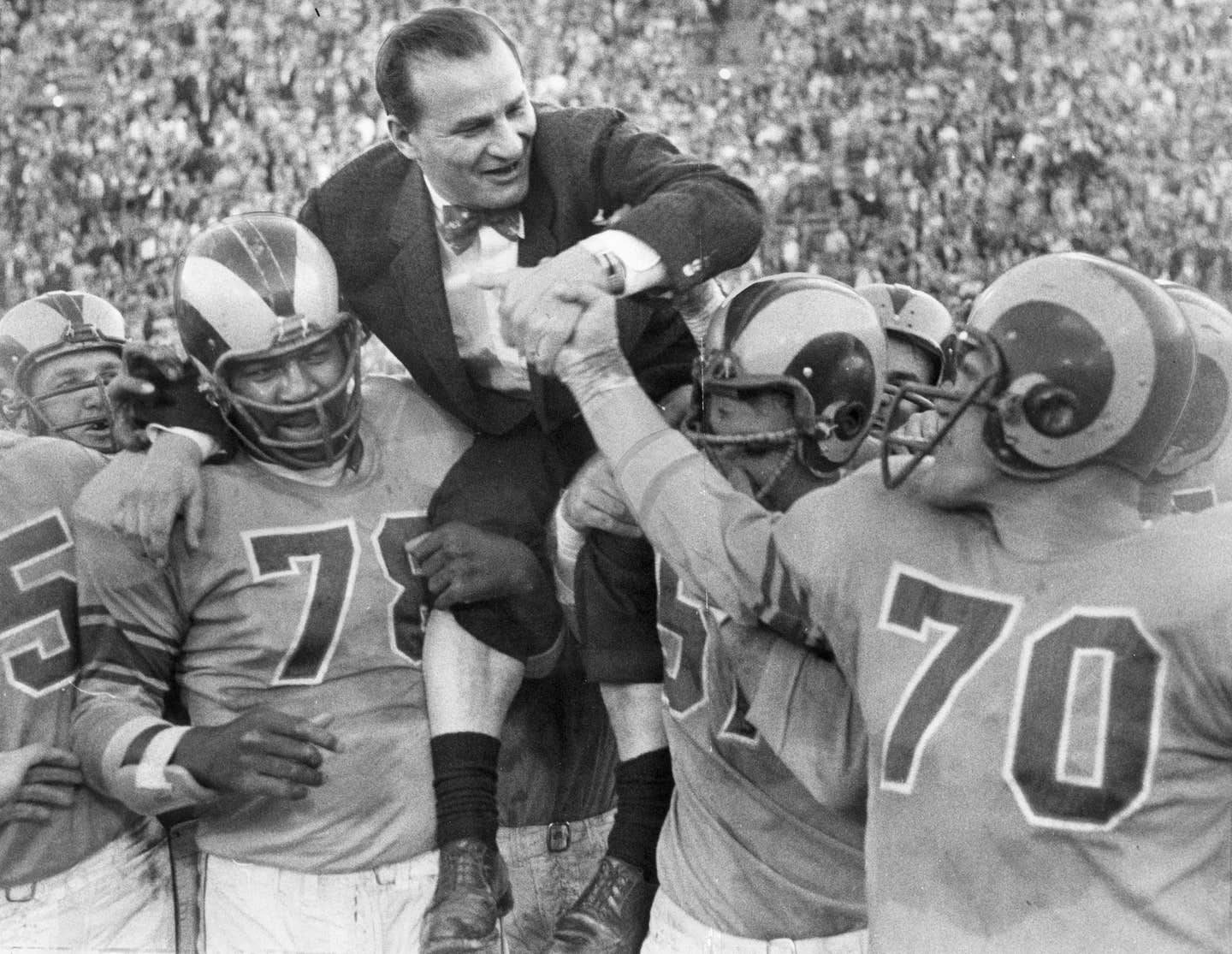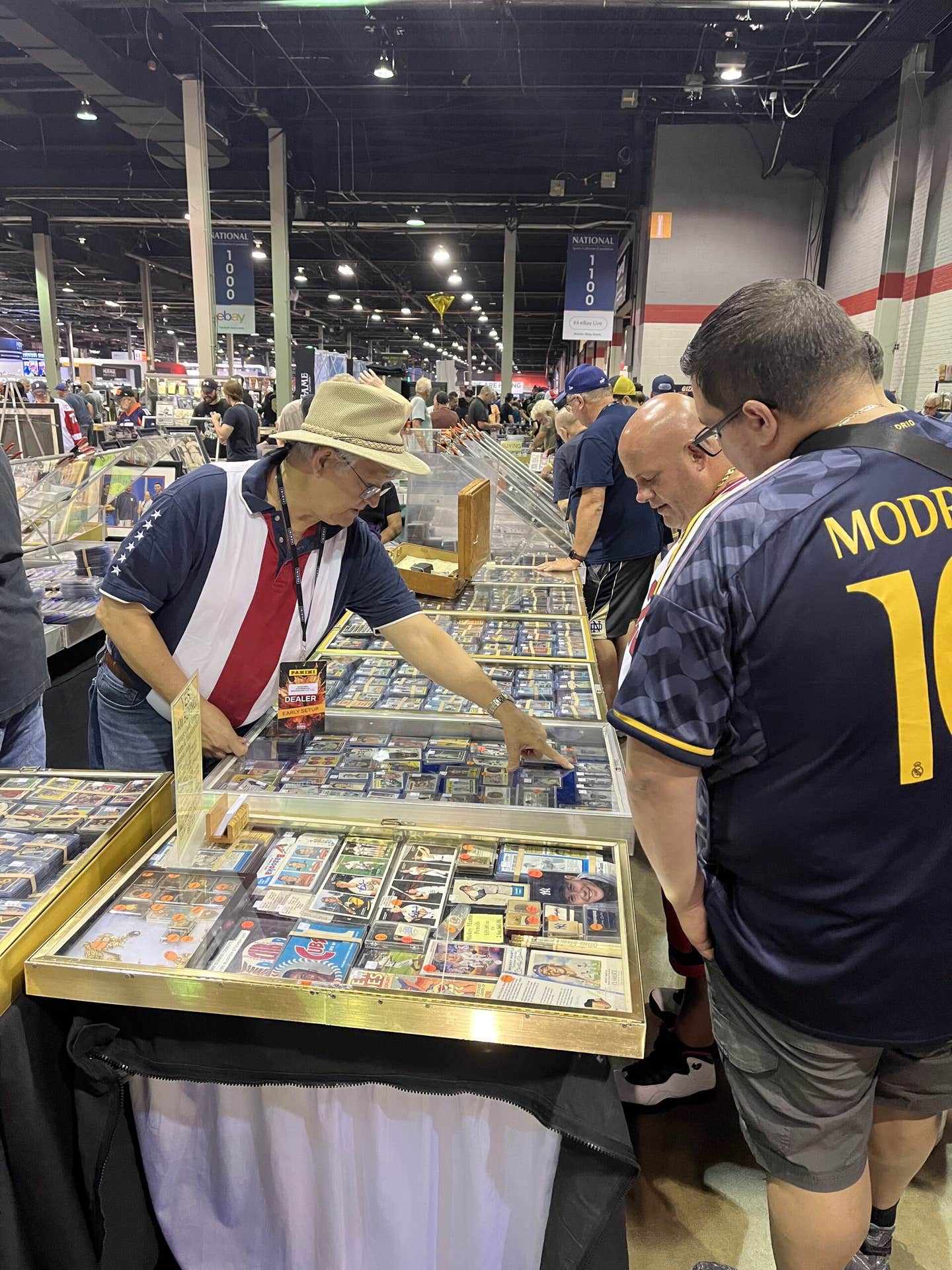
News
BOWMAN’S LAST HURRAH: Historic 1955 Bowman football set the last salvo in 1950s ‘Card Wars’
If a time traveler like Marty McFly could use a DeLorean to journey back to November of 1955, he would find himself in the final days of the famous “Card Wars” of the 1950s.
The battle which began in the spring of 1951 was reaching its conclusion. The Bowman Card Company, founded in Philadelphia in 1927 by J. Warren Bowman for the manufacture and sale of chewing gum, was about to surrender to the victorious Topps. The official end came in January of 1956 when Topps paid $200,000 for all of Bowman's assets, most importantly its contractual rights for professional baseball and football cards.
Bowman did not go down without a fight. From 1951-55, it went toe-to-toe with Topps in the baseball card market, even seemingly prevailing in 1955 with its “Television Set” of 320 cards, surpassing Topps' meager 206. The two were even competing in the field of non-sports cards, with both issuing sets of U.S. Presidents, ships and planes, movie and recording stars, and historical figures. These subjects were nothing new to Bowman. The company had been issuing non-sports sets since the early 1930s under its prior name of Gum, Inc.
Thankfully for sports card collectors, right until its last days in the fall of 1955, the company was putting on store shelves penny and nickel packs of its pink chewable slabs found with pictures of gridiron heroes of the National Football League. Meanwhile, owing to Bowman's exclusive NFL license, rival Topps' only football output at the time consisted of sets of college players in 1950, ’51 and, most memorably, 1955.
The 1955 Bowman football set has always been popular with collectors, and not just for its historical significance as the last set issued by the Bowman company. If the 1955 Bowman baseball set looks to the future, specifically the coming of color television, the football set more closely captures the state of 1950s technology. A scene of a child actor opening a pack of Bowman football cards in “Back to the Future” would have fit right in with the remainder of the film's time-traveling theme.
Also See: Bart Starr, Johnny Unitas highlight the most collectible Super Bowl quarterback of all-time
The 1955 Bowmans were the eighth set of football cards issued by the company since 1948, although they were not strictly “annual” as there was no set in 1949 and two sets (identical except in size) in 1952. But the 1955 set was noteworthy not just as Bowman's last set but also as its largest, with 160 cards released in five series of 32 cards each. The cards themselves were slightly oversized by today's standards at 2 ½-by-3 ¾, as were all Bowman baseball and football cards from 1953-55.
It is generally accepted that cards in the first two series (#1-64) are slightly more plentiful than the remaining 96 cards. However, there has been speculation since 1955 that series two (cards #33-64) is less numerous than series one and that series five (#129-160) is more difficult to find than either series three or four. But even today, seven decades after their release, all 1955 Bowman football cards, other than Gem Mint rarities, regardless of series, are relatively available and affordable.
NOT-SO-FRESH DESIGN
The design of the cards is straightforward and typical of football cards of the 1950s. In fact, Bowman seems to have reused its format of the prior year—all portraits and posed action shots—merely replacing the trees, sky and clouds behind players in 1954 with a solid color background. In some cases the company merely recycled the previous year's photograph. For example, Detroit Lions fullback Johnny Olszewski (card #3) appears as he did in his card (#117) in the 1954 set with the photo cropped slightly differently. There are numerous other examples of pictures reused from 1954.
Also See: Bowman bounced back in big way in 1953
Further, as in 1954, a majority of the cards are vertical, while a handful are found in a horizontal format. Like 1954 and all previous Bowman football sets, there are no team cards, checklists, or any other subsets.
Topps must have approved of the format. For its 1956 set, the first football set issued after the Bowman buyout, Topps continued the basic layout for a third year, changing only the background color for some teams.
The background color of each 1955 Bowman card is team specific. For example, each New York Giants player is posed against a green background. Some colors are shared. All Philadelphia Eagles and Green Bay Packers cards have a yellow background. Around each player is a bright aura, as if the players are aliens surrounded by a force field. This makes those cards of players in posed action shots somewhat dramatic. Especially striking is the card of Rams receiver Bob Boyd (#142), where even the ball suspended over his head displays this halo of energy.
Also See: 1955 Bowman baseball review
One of the three adornments on each card front is the team name in large block letters at the top of the card. A second consists of a small black box at the bottom containing only the player's name and team. A number of players selected in the January 1955 draft also have the “Rookie” designation in tiny letters in that box, a feature that rookie card collectors have always appreciated. The third and final addition to the card front is the team insignia usually (but not always) found in a lower corner near the name box, such as the soaring eagle so familiar to Philadelphia fans.
For the backs of the 1955 set, Bowman basically took the backs of its 1954 set and rotated them from horizontal to vertical. The basic statistics, biographies and play diagrams are virtually identical. The only change from 1954 is the elimination of the “Football Quiz.”
OFFSEASON JOBS & WAR VETERANS
Player biographies make for interesting reading. It is hard to believe in this era of million-dollar salaries, but players in 1955 actually had to work for a living in the offseason. Some had glamorous jobs. Hall of Famer Frank Gifford (#7) “fills movie roles in offseason,” in addition to working as a “TV commentator.”
Likewise, Rams guard Harry Thompson (#23) “does movie extra work in offseason,” while Colts halfback Buddy Young (#65) “has his own disc jockey show.” On the other hand, Packer Howard Ferguson (#57) spent his offseasons working in a Louisiana oil field, while teammate Dave Hanner (#131) was employed by a Green Bay fertilizer factory. And the day is long gone when an NFL player had to supplement his salary by running a service station, like Packer Jerry Helluin (#144).
Also See: More collectible Super Bowl QBs
Bowman also provided family information for many players. In most cases this was minimal, such as “Single” or “Married, one child.” My personal favorite is Colts guard Art Spinney (#107), who “was married in May to a New England beauty queen.”
In addition, the number of men who served in either World War II or the Korean War is significant. While some, such as Ray Wietecha (#24) and Al Dorow (#77), are described as playing service football while in uniform, others saw heavy combat action. One was Eddie LeBaron (#26), who was twice wounded as a Marine officer in Korea. Gordy Soltau (#66) was one of the first Navy Seals (then called “Frogmen”) and also served with the OSS, the forerunner of today's CIA.
Another revelation in the biographies is the proliferation of colorful nicknames. While in today's NFL a unique nickname like “Sauce” Gardner is the exception, many players in 1955 enjoyed a distinctive label. Among the 1955 Bowmans were such men as: Leo “The Lion” Nomellini (#104); “Wild Man” Willey (#138); “Iron Man” McLaughlin (#88); “Bootin Ben” Agajanian (#68); Joe “The Jet” Perry (#44); and “Deacon Dan” Towler (#47).
However, the only nicknames to be found on the card fronts were “Jug” Girard (#15), “Buddy” Young (#65), and “Breezy” Reid (#95).
There are a handful of errors in the 1955 Bowman set, none of which was corrected, leaving the set at 160 cards. Two of the errors are hard to fathom. Giants defensive back Emlen Tunnell (#136) has his name misspelled “Tunnel” on his card front, and Steelers halfback Lynn Chandnois (#54) has his last name misspelled as “Chadnois” on both front and back. Strangely, Bowman made the exact same errors in the previous year's set but caught and corrected them in midseason. Thus, while 1954 cards of both players can be found in erroneous and correct versions, all 1955 cards have the names misspelled.
Similarly, Redskins tackle Bob Toneff's (#143) name is misspelled “Toneoff” on the front of his card, while Les Goble's (#50) name is given wrongly as “Gobel” on both sides of his. In addition, Redskins end Hugh Taylor's (#6) nickname “Bones” is misspelled “Bons” in his biography, while the card of Steelers tackle Frank Varrichione (#148) lacks an entry for his age.
BOWMAN STARS
Besides being Bowman's last and largest football offering, the 1955 set is also notable for the high percentage of Hall of Famers it contains. The set's most expensive and desirable card is found in the least plentiful fifth series. As he appeared in the 1951 set and in both 1952 sets, card #152 is the fourth and last card to picture legendary Cowboy coach Tom Landry as a player for the Giants. While he is identified on his card front only as “Halfback,” his biography explains he was a defensive back and punter as well as “in the dual role of player-coach.” As evidence of the set's affordability, even the Landry card can be found in very good condition for less than $100.
There are no less than 30 other Hall of Famers in the set, including rookie cards of Mike McCormack (#2), Len Ford (#14), Dick Stanfel (#36), John Henry Johnson (#42), Jim Ringo (#70), Bob St. Clair (#101), and Frank Gatski (#119).
One other notable rookie card is that of long time sports announcer Pat Summerall (#52).
The set also contains four Heisman Trophy Award winners: Doak Walker (#1), Alan Ameche (#8), Leon Hart (#19), and Vic Janowicz (#133).
With the death of Eagles fullback (and subsequent original Dallas Cowboy) Dick Bielski (#149) on Oct. 15, 2023, only five players from Bowman's final sport set still survive. The youngest of them is Alex “Buck” Lansford, who celebrated his 90th birthday on Nov. 4, 2023. The others are: Bob Haner (#34), Doug Eggers (#114), Leo Sanford (#123), and Bill Howton (#140).
Warren Bowman himself passed away in 1962. If “the Big Pennsylvania Dutchman” (as newspapers described him) made any statements in late 1955 or early 1956 concerning the final issue of Bowman sports cards or the sale of his company, they went unreported. He may not have even noticed or cared, as he had sold all his interest in the Bowman Card Company in 1951 and moved to Florida to be near his real estate development business, his yacht, and his fifth wife.
In 1989, Topps revived the Bowman name, which it had owned for 33 years, releasing sets of Topps cards bearing the classic Bowman name. Well into the 21st century, Topps was issuing baseball cards under the names Bowman Chrome, Bowman Heritage, and Bowman Sterling. However, not one of them possesses the low-tech 1950s charm of the 1955 Bowman football set or the historical significance the set enjoys in the world of sports collectables.
— Contributor James Mercer has a limited number of 1955 Bowman football doubles. To receive one (most likely a VG common) free of charge, send your name and address via email to jamesmercer1946@gmail.com while supplies last.








